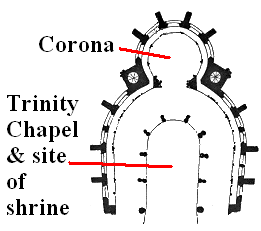Trinity Chapel facts for kids
Trinity Chapel is a special part of Canterbury Cathedral in England. It's so important that it's part of a UNESCO World Heritage Site, which means it's recognized as a place of great value to everyone in the world! This chapel was built by amazing builders named William of Sens and William the Englishman. It was made to be a sacred place for the remains of a famous saint, Thomas Becket. Because of Saint Becket, the chapel became one of the most popular places for pilgrimage (a special journey for religious reasons) in England.
Contents
Why Was Trinity Chapel Built?
The Trinity Chapel you see today was built between 1179 and 1184. It replaced an older, smaller chapel that had the same name. Sadly, the first chapel was destroyed by a big fire in 1174, which also damaged a lot of the cathedral's choir section. The original chapel was where Thomas Becket held his very first church service after he became the Archbishop of Canterbury.
The Story of Thomas Becket
In 1220, Saint Becket's remains were moved from his first burial spot to the newly finished Trinity Chapel. This event made the chapel a huge destination for pilgrims. In fact, it was so popular that it inspired Geoffrey Chaucer to write his famous book, The Canterbury Tales, in 1387! People would travel from places like Southwark and along the Pilgrim's Way just to reach the cathedral.
Becket's shrine stayed in the chapel until 1540. It was destroyed by King Henry VIII, who was angry about something that happened with his ancestor, King Henry II. King Henry VIII also ordered Becket's bones to be destroyed and his name to be removed from records. Today, the spot where the shrine once stood is marked by a lighted candle. Modern Archbishops of Canterbury still hold a special service there to remember Becket's life and the moving of his body to the chapel.
Who Else is Buried Here?
Over time, other important people were buried in this area of the cathedral.
The Black Prince's Tomb
One of the most famous people buried here is Edward Plantagenet, also known as Edward, the Black Prince. He was buried on the south side of where Becket's shrine used to be. His tomb is truly amazing! It has a beautiful golden statue of him lying down, under a special canopy that shows the Holy Trinity (God the Father, God the Son, and God the Holy Spirit). Above the canopy, you can see his family's special symbols and shields. The original symbols are now in a nearby museum, and replicas hang above his tomb. The canopy itself was carefully fixed up in 2006.
King Henry IV's Burial Site
King Henry IV and his second wife, Joan of Navarre, Queen of England, are also buried in Trinity Chapel. King Henry's tomb is on the north side, right next to where Saint Becket's shrine was. It was quite unusual for an English King not to be buried at Westminster Abbey in London. However, Saint Becket was incredibly popular at that time, as shown by The Canterbury Tales.
It's thought that King Henry IV wanted to be connected to Saint Thomas Becket for political reasons. He had taken the throne from his cousin, King Richard II, and wanted to make sure his family's rule was seen as rightful. At his coronation, he was anointed with special holy oil that was said to have been given to Becket by the Virgin Mary. This oil was kept in a golden container shaped like an eagle.
The connection to Saint Thomas is even seen on Henry's tomb. A wooden panel at the end of his tomb shows a painting of Becket's death. The wooden canopy above the tomb has Henry's personal motto, 'Soverayne', and golden eagles. These eagles likely represent the special coronation oil and his link to Saint Thomas. After the King died, a grand tomb was built for him and his queen, probably paid for by Queen Joan. On top of the tomb are detailed statues of the King and Queen, wearing their crowns and royal robes. When historians looked at Henry's body in 1832, they found it was very well preserved, which helped them confirm that the statues look just like him.
What is the Corona Tower?
The Corona Tower, sometimes called "Becket's Crown," is a round building at the very east end of Trinity Chapel. Many people believe it got its name because it was built to hold a relic (a sacred object) from the crown of Saint Thomas's head. However, a historian named Robert Willis wrote in 1845 that "corona" was just a common word for the round eastern parts of many churches in the Middle Ages. Another writer, Erasmus, who visited the cathedral before the shrine was destroyed, said that Saint Becket's head was actually displayed in the crypt (an underground room).
Despite this, records from the 13th century show that pilgrims gave valuable gifts there, suggesting that some relics of Saint Thomas Becket were indeed kept in the Corona. The shrines of other saints, like Saint Odo and Saint Wilfred, were also eventually placed there.


